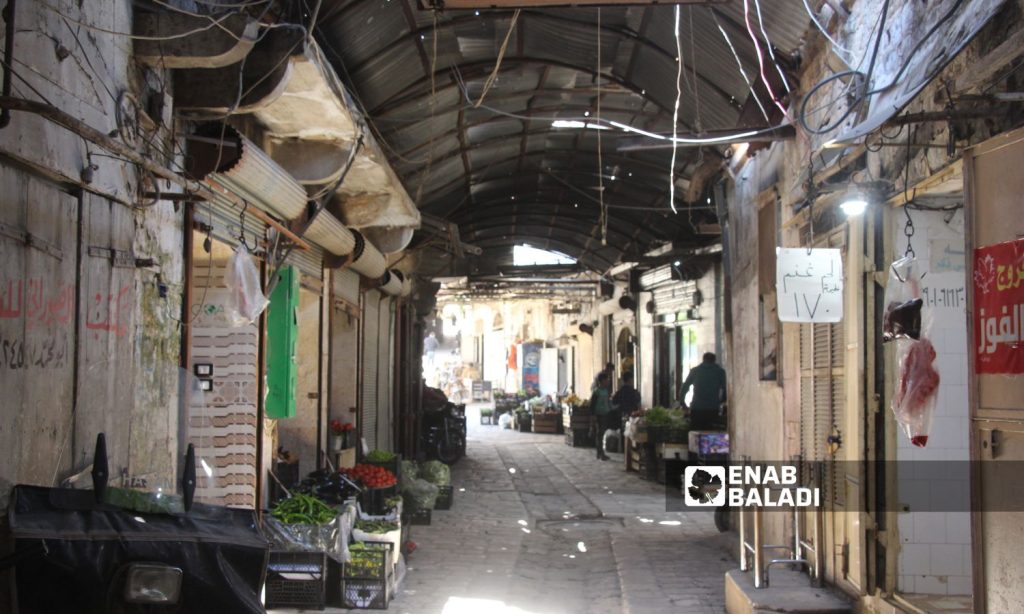Merchants and shop owners in the “old covered market” in the town of Kafr Takharim, northwest of Idlib, complained about the danger of the collapse of the roofs of some shops, which are made of rickety iron and tin sheets.
The merchants expressed their increasing fears about the collapse of the shops and the roof of the market, which maintains an old historical style, from any accident due to natural factors or the bombing of the area, as most of the shops’ roofs are made of dust and wood.
The “Old Market” is the town’s main market and includes shops selling foodstuffs, meat, vegetables, sweets, and old stone ovens.
Rehabilitation demands
Musab Badawi, 45, the owner of a sweets shop in the market, explained to Enab Baladi that the market is very old and its shops need restoration, and that cracked tin ceilings are a problem affecting all market shops.
Badawi, who inherited the shop from his ancestors more than 200 years ago, said that fear accompanies merchants, especially after the earthquake that hit the area on February 6, as the market is old and many of its shops were demolished because of the earthquake.
Badawi explained that the market needs restoration, noting that the most recent restoration operations that took place in it were 30 years ago.
He also called on the Directorate of Antiquities of the Syrian Salvation Government (SSG) operating in the region to be responsible for its restoration in order to make it safe and preserve its importance and historical features.
The owner of the sweets shop pointed out that the merchants are accustomed to the poor roof, and their suffering increases in the winter season as the rain pours into the shops and runs on the market floor.
Mohammad Ridha, 70, owner of a butcher’s shop for 25 years, told Enab Baladi that rainwater infiltration into the shops has become common suffering, as well as the lack of public lighting illuminating the main street.
Ridha pointed out that the continuation of work on the current market situation exposes it to the risk of collapse, especially in the event of any earthquake.
The butcher mentioned that the most recent restoration of the market floor was more than 15 years ago, while the ceilings have not been restored since he worked in the market, pointing out that the merchants stick to working in it because it is ancient and the oldest market in the town and the northern region.
The “old covered market” in the town of Kafr Takharim, northwest of Idlib – May 3, 2023 (Enab Baladi / Iyad Abdul Jawad)
High cost, specialized teams
Zaki al-Aleq, director of the service office in the local council in Kafr Takharim, told Enab Baladi that the market had not witnessed any restoration operations except for its floor, and it was paved with the same quality of black stones that existed previously, pointing to the urgent need to restore the shop’s ceilings and the market’s main ceiling.
Al-Aleq added that the market reached this state for two reasons. The first was the bombing of the town of Kafr Takharim by the regime forces and Russia, which led to the disruption of the market’s buildings. The second was the catastrophe of the earthquake and aftershocks that affected the market greatly.
At least 148 towns and villages in northwestern Syria were affected by the earthquake that struck the region, and more than 1,869 buildings completely collapsed, and more than 8,731 buildings were partially damaged.
Al-Aleq added that the local council is unable to restore the market due to its weak financial capacity and the fact that it needs a high level of technology in restoration and expert teams in antiquities because the existing stones and arches need specialists.
He pointed out that the most important thing the market needs is to restore the roof because its current situation is a danger to the parents and the children, as the market is considered a road for the parents and the children heading to school.
Al-Aleq mentioned that the market represents a destination for the residents of the town and most of the people in the neighboring villages, and it dates back to hundreds of years, calling on the United Nations to include the market and the Umayyad Mosque under the roof of the human heritage and to restore, preserve and rehabilitate it.
Kafr Takharim is full of heritage architectural details, such as old lanes, narrow lanes, houses with tiled roofs in various geometric shapes and decorated with trees, ancient balconies, historical mosques, an ancient bath, and old doors and windows made of wood and sometimes of iron.
A vendor in the “Old Covered market” in Kafr Takharim, northwest of Idlib – May 3, 2023 (Enab Baladi/Iyad Abdul Jawad)
Enab Baladi’s correspondent in Idlib, Iyad Abdul Jawad, contributed to this report.

